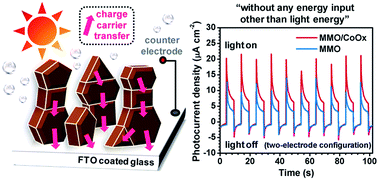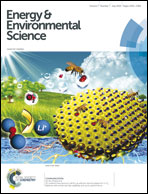An exceptionally facile method to produce layered double hydroxides on a conducting substrate and their application for solar water splitting without an external bias†
Abstract
An exceptionally facile process is presented for in situ formation of zinc chromium layered double hydroxide (ZnCr:LDH) nanosheets on a conducting substrate. Thus, ZnCr:LDH nanosheets were synthesized from a metallic Zn film/fluorine-doped tin oxide (FTO) glass by simply dipping into a Cr nitrate solution for only one minute at room temperature. Then, ZnCr:LDHs were converted into zinc chromium mixed metal oxide (ZnCr:MMO) nanoparticles by calcination. Under visible light irradiation (λ > 420 nm), the in situ synthesized ZnCr:MMO photoanode exhibited a stable and an order-of-magnitude higher activity for photoelectrochemical water splitting than that of a ZnCr:MMO film fabricated ex situ by electrophoretic deposition of already-synthesized ZnCr:MMO powders. More significant was that it generated anodic photocurrents even without an externally applied bias potential, which is an unprecedented result for an oxide photoanode-driven PEC system working under visible light.


 Please wait while we load your content...
Please wait while we load your content...